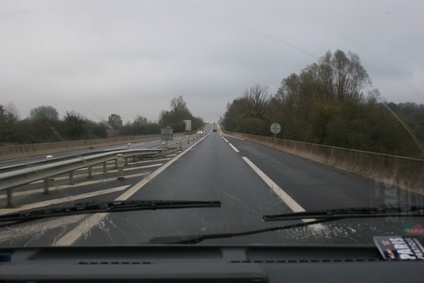
Windshield cracks can confound the most astute vehicle owner, especially when there were no outward signs of a hole, chip or crack to begin with. The next day or two might bring another startling revelation; the crack has lengthened and crossed the entire windshield, distorting his view. The answer lies with a few basic physics facts and also some very obvious reasons.
The most obvious and damaging windshield cracks can be attributed to road hazard impacts, particularly gravel, stones and rocks. They can be kicked up from behind a vehicle or slung across the lane from a car passing in the opposite direction. Obvious strikes show themselves as large chips or holes, which might extend out with primary cracks or "spider-webbing." Some small gravel pieces can leave only a small pit or chip, sometimes microscopic in size, which can be very hard to spot. These small pits or chips collect moisture, and the moisture molecules can expand and contract, pushing the glass in all directions, eventually forming a groove. Such small pits and chips, if not repaired immediately, can expand out and cover the windshield.
The majority of all cracks have their origins very near the edges of the windshield at a point about three inches away from the windshield end mold. Due to the manufacturing process, a weak spot occurs here more often, caused by a thermal effect during the casting process. Since the composition of glass consists of particles and not a liquid substance, the particles have no stable gripping surface at the edge where no glass exists. Also, the mechanical stress that must be used to force the two pieces of glass together against the interior plastic liner also causes imperfections in and around the windshield edges. The very nature of the windshield edge exposes it to more jarring stress, since it binds into the windshield mount galley at the end. The larger, middle area of the windshield can flex and absorb shock, whereas the edge of the windshield must endure the first and heaviest stress loads put upon it.
Variations in temperature that expand and contract the windshield on a continuous basis can often produce small cracks that travel the length of the glass. If the inside air of the vehicle cabin registers 75 degrees and the outside air temperature reads 30 degrees, the inside layer of glass can expand while the outside layer of glass contracts, causing distortion. Any small defect that exists in the windshield can stress and begin to crack. More temperature variation, with the addition of moisture on the windshield, can accelerate the crack's travel.

A deluge of large hail in the form of rock-like stones can impact the glass and cause obvious chip and crack damage. What's worse, multiple strikes can pepper the windshield with numerous cracks and sometimes holes, rendering it useless to repair. Hail damage can be infrequent, but when present can be devastating to all glass panels on the vehicle.